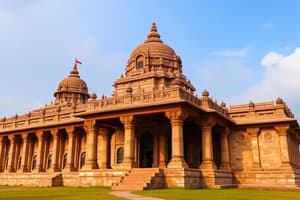Podcast
Questions and Answers
Which of the following best explains the significance of the lion capital found at Sarnath?
Which of the following best explains the significance of the lion capital found at Sarnath?
- It was primarily used as a decorative element to enhance the aesthetic appeal of royal buildings.
- It was placed on pillars as a medium to inscribe Ashoka's instructions and messages. (correct)
- It served as a symbol of Ashoka's military victories and territorial expansion.
- It represents the artistic achievements of sculptors during Chandragupta Maurya's reign.
If a historian aims to understand the administrative and political strategies during the Mauryan empire, which of the following sources would be most valuable?
If a historian aims to understand the administrative and political strategies during the Mauryan empire, which of the following sources would be most valuable?
- Coins and currency from the Mauryan period.
- The Arthashastra written by Chanakya/Kautilya. (correct)
- Personal letters exchanged between Ashoka and his officials.
- The inscriptions on pillars and rock surfaces.
Considering the concept of a dynasty, which statement accurately describes the dynastic succession within the Mauryan empire?
Considering the concept of a dynasty, which statement accurately describes the dynastic succession within the Mauryan empire?
- The Mauryan empire was characterized by a series of rulers from different family lineages.
- The Mauryan empire followed a democratic process where rulers were elected by the people.
- The Mauryan empire saw a consistent transfer of power through alliances with other kingdoms.
- The Mauryan empire had a lineage of rulers, specifically Chandragupta, Bindusara, and Ashoka. (correct)
How did Chanakya contribute to the establishment and administration of the Mauryan Empire?
How did Chanakya contribute to the establishment and administration of the Mauryan Empire?
Roshan noticed the lion capital on her rupee notes. How does this connect to the legacy of the Mauryan Empire?
Roshan noticed the lion capital on her rupee notes. How does this connect to the legacy of the Mauryan Empire?
Flashcards
The Lion Capital
The Lion Capital
The carved lions placed on top of stone pillars at Sarnath, symbolizing Ashoka's rule and principles.
Ashoka
Ashoka
A powerful ruler of ancient India, known for his inscriptions and influence in spreading Buddhism.
Chandragupta Maurya
Chandragupta Maurya
The founder of the Maurya Empire, who ruled more than 2300 years ago.
Chanakya (Kautilya)
Chanakya (Kautilya)
Signup and view all the flashcards
Dynasty
Dynasty
Signup and view all the flashcards
Study Notes
- The lions on notes and coins were carved in stone and placed on a stone pillar at Sarnath.
- Ashoka's instructions were inscribed on pillars and rock surfaces.
Empire Origins
- Ashoka's kingdom was called an empire.
- The empire that Ashoka ruled was founded by his grandfather, Chandragupta Maurya, more than 2300 years ago.
- Chandragupta was supported by Chanakya, also known as Kautilya.
- Chanakya's ideas were written in the Arthashastra.
Dynasty
- A dynasty is when members of the same family become rulers one after another.
- The Mauryas were a dynasty with three rulers: Chandragupta, Bindusara, and Ashoka.
Studying That Suits You
Use AI to generate personalized quizzes and flashcards to suit your learning preferences.
Description
The Mauryan Empire, founded by Chandragupta Maurya and expanded by Ashoka, left its mark through inscribed pillars and rock surfaces. Chandragupta, supported by Chanakya, established a dynasty that included Bindusara and Ashoka.




